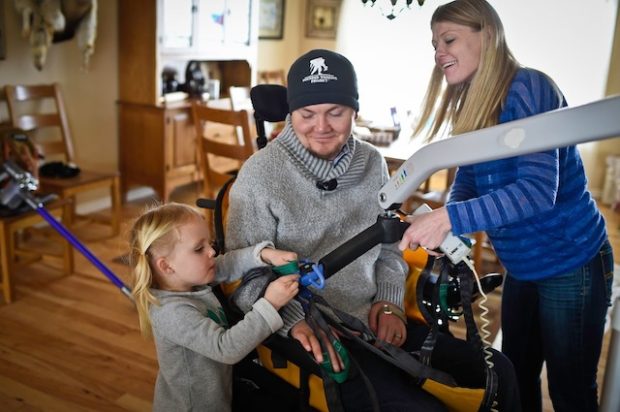
In 2007, retired U.S. Army Staff Sgt. Matt Keil was serving as an infantry squad leader during his second deployment to Iraq in support of the Global War on Terrorism (GWOT). Mid-deployment, Matt returned home for a two-week stint to marry his best friend, Tracy Keil, before returning back to Iraq. Just 43 days after saying his vows, a sniper’s bullet struck Matt in the neck. It severed his spine and left him a quadriplegic.
Instantly, Matt’s and Tracy’s life together was forever changed. Although Matt was no longer in a combat zone, he and Tracy knew they were facing a new battle – recovery. Still, they never expected that fight to lead them to Capitol Hill.
Since 9/11, 2.4 million brave service members have deployed around the world in support of GWOT. Improvements in military medicine and technology save warriors from potentially fatal injuries, only to return them home to America’s broken promise of providing the benefits they earned and deserve. Of the more than 52,000 service members who have been physically wounded in combat to date, it is estimated that between 1,800 and 2,000 veterans suffered an injury that makes it impossible for them to have children.
The solution? Fertility treatment – specifically in vitro fertilization (IVF) – became the only option for many injured warriors to start a biological family.
IVF was initially covered in the health care offered by the Department of Defense (DoD) and the Department of Veterans Affairs (VA). But when the Veterans Health Care Act of 1992 was signed into law, it removed IVF from approved treatments administered by the VA for separated veterans, leaving only active-duty service members covered under the DoD.
Many would learn of this change too late.
“We were just swallowing the fact that he was never going to go back to work,” Tracy says, explaining their early retirement decision was made without understanding they were losing the fertility care benefits they earned. “This is a direct result of a combat injury,” says Tracy. “Don’t tell me that his service wasn’t good enough for us to have a chance at a family. Because we’ve already lost so much. I just want to have a family with the man that I love.”
According to the American Society for Reproductive Medicine, the average cost for a single IVF treatment averages at $12,000 per cycle. However, according to the National Infertility Association, per-cycle success rates are based on a variety of medical factors—some of which can be further impacted by the type of combat injury sustained by the veteran—such as weight, sperm count, and ovarian reserve. If families need multiple cycles, IVF expenses can sometimes reach upwards of more than $50,000.
Congress has left this expense to our nation’s injured heroes for more than two decades since the 1992 law passed.
The irony is insulting. Injured veterans have been left to pay for the very thing they sacrificed their health to protect – family.
“These veterans have made a tremendous sacrifice for our country, and we owe it to them to have the opportunity to start a family. In addition to battlefield trauma, for many of these brave veterans and their families, enduring the stress and anxiety of not knowing whether they can afford costly IVF treatments can be very difficult to bear,” said Sean Foertsch, government and community relations director at Wounded Warrior Project® (WWP).
Still, Congress underestimates the spirit of these warriors and their supporters. Advocates have urged lawmakers to pass a bill recently introduced to Congress that would require the VA to cover fertility treatment for those veterans who received combat- or training-related injuries. Last month, Matt and Tracy joined WWP and other affected veterans on Capitol Hill to raise awareness of needed fertility benefits and to ask the government to uphold the promise made to veterans by passing the bill into law.
There have been other bills proposed to lift the VA ban on IVF treatment, but no agreement was made between legislative parties. Like its predecessors, to become a law this bill is required to not only pass both the U.S. House of Representatives and the U.S. Senate, but also be approved by the President. It’s a process much like the modern story line for a pinball machine. As long as Congress keeps the ball in play, the game will never end.
The Keils refused to wait for Congress to honor its promise. Pulling more than $32,000 from their personal savings, the Keils paid for something no wounded veterans should have to…
“The title of ‘dad’ or ‘mom’ is probably the best title that any person that walks this earth could have,” says Matt. While he and Tracy now have those titles, there are others still fighting for them. You can join their fight. Contact Congress now. Visit the Wounded Warrior Project Action Center at https://goo.gl/dhdXMt.
About Wounded Warrior Project
The mission of Wounded Warrior Project® (WWP) is to honor and empower Wounded Warriors. The WWP purpose is to raise awareness and to enlist the public’s aid for the needs of injured service members, to help injured servicemen and women aid and assist each other, and to provide unique, direct programs and services to meet their needs. WWP is a national, nonpartisan organization headquartered in Jacksonville, Florida. To learn more about WWP and the Benefits Service program, visit woundedwarriorproject.org. (Photos courtesy WWP)
The Fight on Capitol Hill
By Vesta M. Anderson




